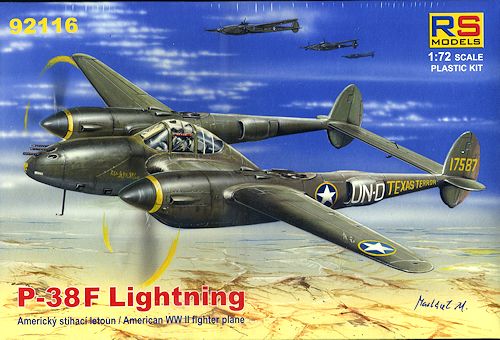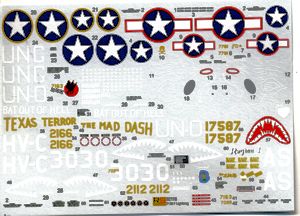
RS Models 1/72 P-38F Lightning
| KIT #: | 92116 |
| PRICE: | $25.17 on sale ($39.95 SRP) |
| DECALS: | Five options |
| REVIEWER: | Scott Van Aken |
| NOTES: | Short run kit |

| HISTORY |
After 210 P-38Es were built, they were followed, starting in April 1942, by the P-38F, which incorporated racks inboard of the engines for fuel tanks or a total of 2,000 lb (907 kg) of bombs. Early variants did not enjoy a high reputation for maneuverability, though they could be agile at low altitudes if flown by a capable pilot, using the P-38's forgiving stall characteristics to their best advantage. From the P-38F-15 model onwards, a "combat maneuver" setting was added to the P-38's Fowler flaps. When deployed at the 8° maneuver setting, the flaps allowed the P-38 to out-turn many contemporary single-engined fighters at the cost of some added drag. However, early variants were hampered by high aileron control forces and a low initial rate of roll, and all such features required a pilot to gain experience with the aircraft, which in part was an additional reason Lockheed sent its representative to England, and later to the Pacific Theater.
The aircraft was still experiencing extensive teething troubles as well as being victimized by "urban legends", mostly involving inapplicable twin engine factors which had been designed out of the aircraft by Lockheed. In addition to these, the early versions had a reputation as a "widow maker" as it could enter an unrecoverable dive due to a sonic surface effect at high sub-sonic speeds. The 527 P-38Fs were heavier, with more powerful engines that used more fuel, and were unpopular in the air war in Northern Europe. Since the heavier engines were having reliability problems and with them, without external fuel tanks, the range of the P-38F was reduced, and since drop tanks themselves were in short supply as the fortunes in the Battle of the Atlantic had not yet swung the Allies' way, the aircraft became relatively unpopular in minds of the bomber command planning staffs despite being the longest ranged fighter first available to the 8th Air Force in sufficient numbers for long range escort duties. Nonetheless, General Spaatz, then commander of the 8th Air Force in the UK, said of the P-38F: "I'd rather have an airplane that goes like hell and has a few things wrong with it, than one that won't go like hell and has a few things wrong with it."
As unsuitable as they may have been in Northern Europe (where the Germans considered them easy targets), the F model worked well at the lower altitudes of the Mediterranean and the southwest Pacific; especially the latter where its range was very much appreciated.
| THE KIT |
 All
RS Models kits are basically short run kits and this one is no exception. Though
it is devoid of the photo etch that one often sees in these sorts of kits, it
does have a small resin fret for the nose gun barrels. I found that on the
engine pieces, sections of the mating surfaces were filled in with plastic. This
will need to be removed prior to assembly. The larger pieces also have ejector
towers that will need to be sanded down in order to get the parts to properly
join. One thing I noticed on the sprues is that parts 5 and 6 had been removed.
Looking through the instructions I did not see where these would be used on this
kit, so hopefully this will not be an issue.
All
RS Models kits are basically short run kits and this one is no exception. Though
it is devoid of the photo etch that one often sees in these sorts of kits, it
does have a small resin fret for the nose gun barrels. I found that on the
engine pieces, sections of the mating surfaces were filled in with plastic. This
will need to be removed prior to assembly. The larger pieces also have ejector
towers that will need to be sanded down in order to get the parts to properly
join. One thing I noticed on the sprues is that parts 5 and 6 had been removed.
Looking through the instructions I did not see where these would be used on this
kit, so hopefully this will not be an issue.
The cockpit is well appointed with a nice seat rudder pedals, instrument panel, control stick as well as having side walls with detail and a radio rack for behind the cockpit's armor plating. The nose gear well is a two piece affair that fits into the lower fuselage half. There is not a ton of space for weight, so I suggest filling as much of the room as you can to ensure you do not have a tail sitter.
On the booms, there is a single piece well for each main gear. The coolers on each side have an insert for the front and rear of the radiator. Atop are some scoops and the turbocharger outlet. The kit provides individual propeller blades, which I personally detest and there is no key to ensure they are all at the same pitch. Engine fronts are separate to allow the later versions to be done. Inserts for the intakes are provided for this version.
Landing gear are nicely done with two piece main wheels. Aftermarket will help if there are any. The boom side intake scoops are two pieces. Attachment of the main gear doors looks like most every P-38 I have ever built. It will be interesting to see if these actually fit well. You do get two racks for under the wings which are butt joins. These can carry either bombs or drop tanks. The kit provides a one piece canopy which has the proper rounded windscreen. If you wish to add the armored piece on the inside, you will need to fabricate that. As with most P-38 kits in this scale, there is no boarding ladder.
Instructions are well drawn with detail bits to help
with alignment and parts placement. Color information is provided in generic
terms. Though it does not mention it, the builder needs to know that the props
turn opposite each other so it would be wise not to get the blades on the wrong side. I recommend
building each prop separately and then scratching an L or R one one to keep
things straight. The back of the instructions is a three view showing where all
the data markings are to be placed.
so it would be wise not to get the blades on the wrong side. I recommend
building each prop separately and then scratching an L or R one one to keep
things straight. The back of the instructions is a three view showing where all
the data markings are to be placed.
 Markings are
for five aircraft, all in OD/Neutral Grey. The back of the box has full color
markings information. First is an F-1 of the 94 FS/1 FG in Algeria during early
1943. It is also the box art plane. Next, with red spinners is a 27 FS F-1
variant in Tunisia during 1943. The lone pacific bird is with the 39 FS/35 FG at
Port Morseby in January 1943. It is an F-5 version. The first F-15 variant is
with the 95FS/82 FG in Algeria during May of 1943. Finally, another F-15, this
one with yellow spinners with the 94FS/1 FG based on Sardinia during 1943. This
one is named 'Bat outta hell'. The decal sheet is nicely done and appears free
of registration issues.
Markings are
for five aircraft, all in OD/Neutral Grey. The back of the box has full color
markings information. First is an F-1 of the 94 FS/1 FG in Algeria during early
1943. It is also the box art plane. Next, with red spinners is a 27 FS F-1
variant in Tunisia during 1943. The lone pacific bird is with the 39 FS/35 FG at
Port Morseby in January 1943. It is an F-5 version. The first F-15 variant is
with the 95FS/82 FG in Algeria during May of 1943. Finally, another F-15, this
one with yellow spinners with the 94FS/1 FG based on Sardinia during 1943. This
one is named 'Bat outta hell'. The decal sheet is nicely done and appears free
of registration issues.
| CONCLUSIONS |
Though Academy may have done one of these earlier P-38s in this scale, the only one I can say for sure who did one is Airfix, and that is rather long in the tooth. This kit has everything you need to make an excellent replica and I'm sure those who wish to embellish it will find it a good starting point.
| REFERENCES |
http://en.wikipedia.org/wiki/Lockheed_P-38_Lightning
August 2013
Thanks to me for grabbing this one on sale.
If you would like your product reviewed fairly and fairly quickly, please contact the editor or see other details in the Note to Contributors.